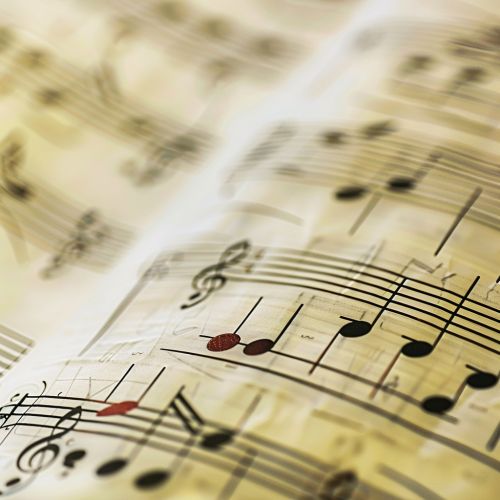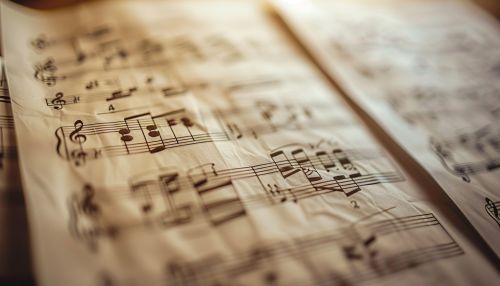Sheet music
Introduction
Sheet music is a form of musical notation that uses printed symbols to represent the pitches, rhythms, or chords of a song or instrumental musical piece. It serves as a visual record of music, allowing musicians to perform a piece exactly as the composer intended. Sheet music can be written for any instrument or group of instruments and can range from simple melodies to complex symphonic works.
History
The history of sheet music extends back to the earliest forms of music notation, which were found in the forms of cuneiform inscriptions on clay tablets from ancient Sumerian civilization. The evolution of sheet music has been influenced by various factors, including technological advancements, musical styles, and cultural shifts.
Ancient and Medieval Periods
The earliest forms of sheet music were notated using neumes, a system of musical notation used in the Middle Ages. Neumes were used to notate Gregorian chants, which were the primary form of music in the Christian church during this time. The use of neumes gradually evolved into the use of staff notation, which is the system of notation used in modern sheet music.
Renaissance and Baroque Periods
During the Renaissance and Baroque periods, the printing press revolutionized the distribution of sheet music. The invention of movable type by Gutenberg in the 15th century allowed for the mass production of sheet music, making it more accessible to the general public.
Classical and Romantic Periods
In the Classical and Romantic periods, the development of the piano led to a significant increase in the production of sheet music. Composers such as Beethoven, Mozart, and Schubert wrote many of their works for the piano, and their compositions were widely distributed in the form of sheet music.
Modern Period
In the 20th and 21st centuries, the advent of digital technology has further transformed the production and distribution of sheet music. Today, sheet music can be accessed and shared digitally, making it even more widely available to musicians and music enthusiasts around the world.


Types of Sheet Music
There are several types of sheet music, each designed for a specific purpose or type of performance. These include scores, parts, lead sheets, and fake books.
Scores
A score is a complete representation of a musical work, showing all parts and voices together. Scores are used by conductors and music directors to study a piece of music in its entirety and to direct performances.
Parts
A part is a form of sheet music that contains the music for a single instrument or voice. Parts are used by individual musicians during performances, especially in ensembles or orchestras.
Lead Sheets
A lead sheet contains the melody line, lyrics, and chord symbols for a song. Lead sheets are commonly used in popular music and jazz for quick and easy performances.
Fake Books
A fake book is a collection of lead sheets. Musicians use fake books to perform a wide variety of songs without having to carry around multiple pieces of sheet music.
Reading Sheet Music
Reading sheet music involves understanding the various symbols and notations used to represent musical sounds. These include clefs, key signatures, time signatures, notes, rests, and other musical symbols.
Clefs
A clef is a symbol that indicates the pitch range of the staff. The most common clefs are the treble clef, used for higher-pitched instruments and voices, and the bass clef, used for lower-pitched instruments and voices.
Key Signatures
A key signature indicates the key of the piece, which determines the scale that the music is based on. The key signature is represented by a series of sharps or flats at the beginning of each line of music.
Time Signatures
A time signature indicates the meter of the music, which determines the rhythmic structure of the piece. The time signature is represented by two numbers, one above the other, at the beginning of each line of music.
Notes and Rests
Notes represent the pitches of the music, while rests represent silences. The shape and position of a note on the staff indicate its pitch and duration, while the type of rest indicates its duration.
Digital Sheet Music
With the advent of digital technology, sheet music has evolved to include digital formats. Digital sheet music can be viewed on computers, tablets, and smartphones, and can include interactive features such as playback, transposition, and annotation.
Software
There are several types of music notation software available that allow musicians to create, edit, and print their own sheet music. These programs can also include features for playback, transposition, and part extraction.
Online Platforms
There are many online platforms that offer access to digital sheet music. These platforms often include libraries of sheet music from various genres and periods, and may offer features such as interactive playback and transposition.
